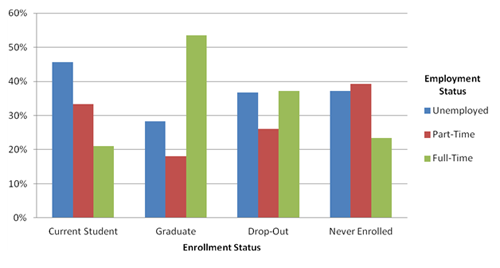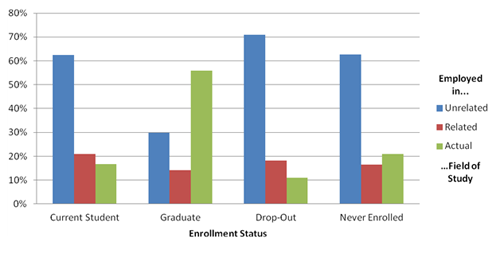We have been talking a lot about a study Wonderlic and the Imagine America Foundation (IAF) recently conducted to determine what factors influence student engagement.
To a large extent, student engagement occurs when students make a significant, psychological investment in their learning. Student engagement is affected by school resources and student characteristics. In an earlier
blog post, we discussed how important it is for students to have support outside of school. This greatly affects their level of engagement, which in turn affects their graduation rates. In addition to collecting data on students who are currently enrolled at career colleges, we also sampled graduates, drop-outs, and those who decided not to enroll. This allows for fruitful comparisons between students who were more engaged students (graduates) and disengaged students (drop-outs). Indeed, our analyses demonstrated that graduates were substantially more engaged than drop-outs.
The graph below depicts the employment status (unemployed, part-time employed, full-time employed) for each enrollment status category (current students, graduates, drop-outs, never enrolled).

When compared to current students, drop-outs, and those who never enrolled, individuals who graduated have the highest rate of full-time employment and the lowest rate of unemployment. Perhaps of main importance, our analyses also suggest that engaged students are more likely to be employed full-time when compared to disengaged students. That is, career college graduates are 1.5 times more likely to be employed full-time when compared to drop-outs (53% vs. 35%).
While career college graduates are more likely to be employed full-time, this is only part of the story. Another interesting finding from our analyses is that graduating conveys gainful employment. As the graph below depicts, of those who are employed at least part-time, graduates are 5 times more likely to be employed within their field of study when compared to drop-outs (56% vs. 11%).

Given the recent amount of attention paid to career colleges’ need to better
prepare students for gainful employment, our results are very promising. Overall, graduates are more likely to be employed full-time and within their field of study. Importantly, our model suggests that this is largely due to differences in student engagement. That is to say,
engaged students are more likely to graduate and obtain gainful employment as compared to disengaged students.
To this end, ensure that your students are engaged learners by focusing on improving your school resources and student characteristics.
 When compared to current students, drop-outs, and those who never enrolled, individuals who graduated have the highest rate of full-time employment and the lowest rate of unemployment. Perhaps of main importance, our analyses also suggest that engaged students are more likely to be employed full-time when compared to disengaged students. That is, career college graduates are 1.5 times more likely to be employed full-time when compared to drop-outs (53% vs. 35%).
While career college graduates are more likely to be employed full-time, this is only part of the story. Another interesting finding from our analyses is that graduating conveys gainful employment. As the graph below depicts, of those who are employed at least part-time, graduates are 5 times more likely to be employed within their field of study when compared to drop-outs (56% vs. 11%).
When compared to current students, drop-outs, and those who never enrolled, individuals who graduated have the highest rate of full-time employment and the lowest rate of unemployment. Perhaps of main importance, our analyses also suggest that engaged students are more likely to be employed full-time when compared to disengaged students. That is, career college graduates are 1.5 times more likely to be employed full-time when compared to drop-outs (53% vs. 35%).
While career college graduates are more likely to be employed full-time, this is only part of the story. Another interesting finding from our analyses is that graduating conveys gainful employment. As the graph below depicts, of those who are employed at least part-time, graduates are 5 times more likely to be employed within their field of study when compared to drop-outs (56% vs. 11%).
 Given the recent amount of attention paid to career colleges’ need to better prepare students for gainful employment, our results are very promising. Overall, graduates are more likely to be employed full-time and within their field of study. Importantly, our model suggests that this is largely due to differences in student engagement. That is to say, engaged students are more likely to graduate and obtain gainful employment as compared to disengaged students.
To this end, ensure that your students are engaged learners by focusing on improving your school resources and student characteristics.
Given the recent amount of attention paid to career colleges’ need to better prepare students for gainful employment, our results are very promising. Overall, graduates are more likely to be employed full-time and within their field of study. Importantly, our model suggests that this is largely due to differences in student engagement. That is to say, engaged students are more likely to graduate and obtain gainful employment as compared to disengaged students.
To this end, ensure that your students are engaged learners by focusing on improving your school resources and student characteristics. 
